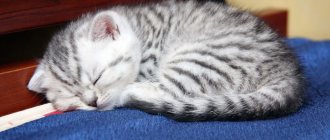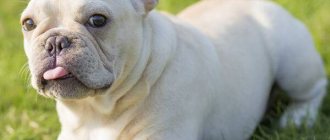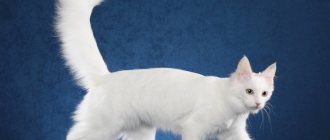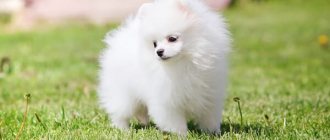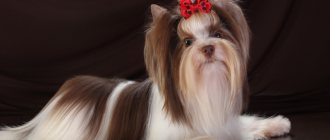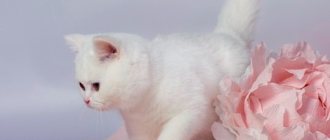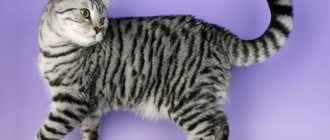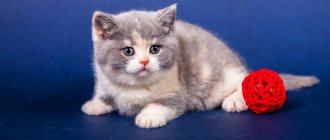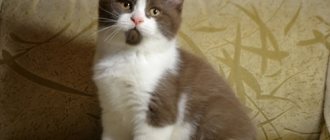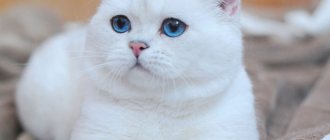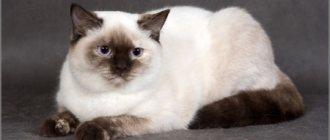British among cats
This breed is popular due to its independent and patient disposition, because British women will never get bored in the absence of their owner. At the same time, plush purrs are not devoid of a sense of tact and show full love to those who take care of them and treat them with tasty treats.
British cats are the embodiment of calm and intelligence
The British are distinguished by high intelligence - by changing the “notes” in the breadwinner’s voice, the cat will understand that it is doing something wrong. However, these little cats cannot be called too mischievous or vindictive - calmness is their strong point. At the same time, British cats are not inclined to become toys in children's hands; with excessive attention from children, the cat will prefer to run away.
Externally, British catfish differ in the following parameters:
- thick coat with dense undercoat;
- round, close-set eyes of amber color;
- massive head on a short neck;
- wide cheekbones;
- small nose with a wide bridge;
- ears widened at the base with rounded tips;
- muscular body on wide, strong legs;
- medium-length tail, rounded at the end.
How the color of the Briton was formed
There are several versions of the origin of the breed - one says that the ancient Romans brought cats from the Egyptian desert in the 1st-2nd centuries. ad. According to another legend, British cats originate from the purring Chartreuse breed, taken by medieval crusaders from the shores of South Africa.
Chartreuse cats are considered possible ancestors of the British breed
The first true Britons who settled Foggy Albion had gray-blue “stuffed” fur. This is how they were depicted in religious treatises (for example, in the Lindisfarne Gospel), poems and bestiaries. Zoologists began selection, which fixed the color, only in the 19th century, at which time the first breed standard was drawn up.
Color is the color scheme and patterns on a cat's fur coat that are formed as a result of the interaction of genetic materials responsible for the production of melanin in the body. The desired shade of coat is obtained by crossing animals with dominant and recessive genes responsible for the pattern and depth of tone. So, in British dogs with blue hair, the set of genes looks like BBdd (where B is the dominant gene that forms the black color, and d is the recessive gene responsible for muted, diluted shades). Marbled cats carry the Tb gene (where T is the dominant tabby color gene, and b is a recessive gene that makes the coat brownish, not black).
Felinologists became concerned with professionally establishing breed characteristics (including color) in British cats only after the Second World War, when the question arose of preserving this variety of domestic purrs:
- 1950 - official recognition of the British Blue breed;
- 1967 - British blue cats received the champion title from the ACA association;
- 1977 - ban on mating with other breeds, including Chartreuse;
- 1980 - recognition of the breed by the CFA Association.
Where did this color come from and why is it called that?
The question of where cats of such bizarre colors and different breeds come from will certainly arise if a British kitten appears in the house. The tabby color was most likely inherited by domestic cats from their wild ancestors, the Nubian Dun. It is from this species of cat that all our short-haired pets originated.
As for the term “tabby” itself, there are several versions about its origin. The most beautiful sounds like this. Somewhere at the beginning of the 17th century, silk fabrics, which were worth their weight in gold, were first brought to England. Their pattern was very similar to a cat's color and was called "tabbis". And when they later began to breed cats with a similar color, they were called tabby. In addition, cats of this color, like silk, were very expensive, since breeding them is extremely difficult - it is difficult to obtain the necessary pattern, shade and eye color that matches them.
SPOTTED TABBY, LEOPARD COLOR BRITISH
The British spotted cat can also be called Spotted tabby or leopard, which, in principle, is the same thing. The color must invariably include: the letter “M” on the forehead, “necklaces”, stripes on the paws, rings on the tail, spots on the belly, a contrasting pattern, eyeliner and nose, all according to the standard.
The spotted color is the most common of all tabby colors. The British spotted cat looks elegant and looks like a leopard, which is why it received this second name for the color. British spotted kittens can be born from parents of any tabby color. Eyes can be copper or green (green eye color is characteristic of golden and sometimes silver colors).
We suggest you read: Childbirth in a cat - how to give birth to a cat at home?
Photo of a British tabby kitten, black silver spotted color BRI ns 24
| British tabby, photo of chocolate silver ticked British kitten BRI bs 25 | Photo of a British tabby kitten: lilac ticked BRI c | British tabby cat, photo of golden ticked Briton BRI ny 25 |
| Photos of British tabby kittens: red ticked color BRI d 25 | British tabby cat, photo of red silver color BRI ds 25 | British cat tabby color, photo of cream silver ticked color BRI es 25 |
| British spotted cat cinnamon BRI o 24 | British brindle kitten, photo red British BRI d 23 | British brindle (striped) tabby cat, photo of a chocolate tabby British kitten BRI b 23 |
| British tabby (tiger) cat, photo of black silver British tabby BRI ns 23 | British spotted cat, photo of blue spotted tabby color BRI a 24 | British tabby, photo of lilac spotted British tabby kitten BRI c 24 |
| British tabby, photo of tortoiseshell spotted color BRI f 24 | British tabby cat, photo of chocolate spotted British kitten BRI b 24 | Leopard tabby color, photo of golden spotted British kitten BRI ny 24 |
| British tabby, photo of tortoiseshell tabby color BRI q 23 | Marbled British kitten, photo of chocolate marbled British kitten BRI b 22 | British merle kitten, photo fawn harlequin color BRI p 22 |
| Marbled British cat, photo cinnamon marbled color BRI o 22 | British tabby cat, photo cream tabby color BRI e 22 | British marble on silver, photo red marble British tabby BRI ds 22 |
| British kitten, photo of marbled chocolate color BRI b 22 | British merle cat, photo lilac merle British tabby BRI c 22 | British merle kitten, photo of black golden merle BRI ny 22 64 |
| British black marbled on silver, photo of tortoiseshell silver British kitten BRI fs 22 | British blue marble, photo of black blue marble British tabby kitten BRI a 22 | British merle cat on silver, photo of black merle British tabby color BRI ns 22 64 |
| Silver merle Briton, photo of British merle color on silver tabby BRI ns 22 | British tabby, photo color point tabby color BRI a 33 21 | British cat black marbled bicolor, photo of color black silver marbled bicolor tabby BRI ns 03 22 |
Types of drawings
Tabby is not one specific pattern, as many people believe. There are several varieties of it, and all are considered standard. The pattern appears due to the A gene (agutti). A British female with the color formula “AA” gives birth to only patterned kittens, and with “Aa” the ratio of patterned kittens to plain ones is 50%. Cats with the formula “aa” will be monochromatic.
There are four main types of tabby patterns: ticked, striped, marbled, spotted.
Ticked (Abyssinian)
At first glance, it may seem that the British ticked coat is a solid color, but this is not the case. The color of their coat is not at all uniform: the whole body has barely noticeable stripes, spots or specks (there are “freckles”), slightly darker than the main tone of the British. The tip of the tail is usually dark. Eyes are golden or green.
Striped, brindle (mackerel)
The British tabby cat is the most popular cat available. The second name appeared due to the similarity with the color of the mackerel fish. The pattern is characterized by frequent narrow, clear stripes throughout the body, especially along the ridge. British tabbys are characterized by necklace-like lines on the chest and a broken stripe on the forehead, reminiscent of the Russian letter “M”. The British cat's full brindle coloration develops by the age of one year.
Classic (marble)
One of the most favorite colors among breeders of this breed is the marbled tabby. It is visible already from the birth of the kitten, it may merge slightly, but by two months it has a clear pattern. The body is covered with wide ornate patterns with clear outlines on the back, sides and vague ones on the abdomen and paws. The color of the pattern contrasts with the main shade of the Briton’s body – a kind of marble on silver.
Spotted (leopard)
A cat of the British breed with this coloring is similar to a representative of the wild - a leopard, but in miniature. Wide stripes are intermittent and represent spots of various sizes. Eye color: copper, green.
Where does the British marbled cat come from?
Since the beginning of the 20th century. British cats included not only plain blue animals, but also tabby cats with different shades on their fur coats. Thus, in 1901, American felinologists registered a Belle cat with a red tabby color.
British marbled cats appeared as a result of crossing with other breeds
The consequence of two world wars was the almost complete extermination of the British breed, so breeders began to crossbreed pets with representatives of other varieties - Burmese, Russian Blues, Persians and Scottish. The result was the appearance of many varieties of British color while simultaneously preserving the breed characteristics (wide paws, protruding cheekbones, “plush” coat).
At the same time, among all the variations of the striped coat of the British fur coat, it is the marble color that is considered classic, occurring naturally. Zoologists are inclined to believe that the symmetrical darkening on the fur of catfish from Foggy Albion is an inheritance from wild Asian or African ancestors.
Notes [ edit | edit code]
Very characteristic cats, sometimes even aggressive ones
British cats, whose breeding began at the end of the 19th century, are to this day the true pride of Great Britain. Large cats with plush fur, according to legend, inherited their smile from the Cheshire cat. The first snow-white beauty belonging to this breed was officially presented at the exhibition in 1987. To this day, the colors of British cats are of particular interest to cat lovers. There are no British Folds; this anatomical feature is inherent in Scottish cats.
Since then, the popularity of the breed has been steadily growing. The British attract not only their intelligent character and plush fur, but also a huge variety of colors, of which there are more than 25 types. A table with photos will help you study the colors of British cats, as well as a description of the types and types of colors of this breed. Among the color range of wool there are very rare combinations that are extremely highly valued by both professional breeders and breed lovers. Let's figure out what colors British cats come in.
How to get marbled kittens
Considering that color can be obtained if gene A is present, two marbled cats are brought together. In this case, you can be guaranteed to get almost all the kittens of the desired shade. In addition, spotted babies are born from the mating of spotted and brindle parents. However, it is important to consider the fact that their mom and dad were supposed to be marble.
Breeders with extensive experience note that in a large number of cases the result is not what you want. And if so, then the color can no longer be considered standard.
Usually it makes itself known:
- Shading. In this case, the marble is “washed away”, not as rich as it should be.
- Extra ticking. The drawing is poorly visible.
- Expressiveness. The difference between the background and the pattern is so noticeable that it looks rather ugly than bright.
- Torn drawing. In this case, the stripes are not only interrupted, but also intertwined with other lines.
To get the desired result, you need to choose your parents wisely.
Types of merle colors among the British
This color belongs to a group of colors called tabby (from the name of the striped fabric brought to England from Baghdad). The peculiarity of this pattern is the continuity of lines and the uniqueness of the pattern for each individual. Thanks to the efforts of felinologists, today the British marble coat is represented by many varieties.
Black marble
The main background of the coat is dark gray, the stripes have a pronounced black tint. There is a black outline around the eyes and nose, the color of the eyes is brown-orange.
British black marble shades are highly prized by animal lovers.
Black marble on silver
Charcoal stripes and spirals are symmetrically arranged on a silver background. There are dark spots near the eyes and the red-brown nose.
Black marble on silver - exquisite colors of British cats
Black marble on gold
The main color of the coat is copper-golden, the stripes have a black or dark brown tint. The eyes are most often green or yellow.
The British with the “black marble on gold” color look very presentable
Lilac marble
The silver fur coat is decorated with patterns of lavender or peach undertones. There is also a lavender rim around the nose and eyes. The iris is yellow or pale brown.
British cats with a lilac-marble hue are quite unusual
Tortoise marble
The main background can be silver-red or silver-brown, while the spots and patterns remain black or dark brown. The eyes are often yellow or greenish. The color is characteristic only of females; in rare cases it is found among males. Cats with this color cannot have offspring due to genetic characteristics.
Tortoiseshell marble involves adding reddish shades to the main color scheme
Chocolate marble
The fur coat is the color of milk chocolate, the pattern is dark brown. The eyes and nose are outlined with thick chocolate eyeliner. The color of the iris is from yellow to golden brown.
Chocolate Marble is a common color option among the British.
Bicolor
The main color with spots is diluted with white inserts on the paws, chest and belly. Eyes can be yellow, brown or green.
Bicolor color is also found among British harlequins.
Red marble
The light red fur of the main background is decorated with spots and streaks of a rich red hue. The eyes are orange, brownish-golden.
Red merle is a red British breed with merle patterns on their coats.
Red marble on silver
It is distinguished by a silvery tone of the main background, the spots have a light red color. The fur around the eyes is white, the nose is pink. The eyes are yellow or golden.
Red marble on silver - a spectacular coat color for the British
Cream marble
The main background has a shade of creme brulee, and the spots tend to be peach. There are white hairs around the eyes and a pink nose. Eyes yellow or gold.
Cream marble is a very delicate shade of the fur of British cats.
Blue marble
Silver coat with smoky gray stripes and spots, dark gray lining around the nose. The eyes are not circled and have a brown-golden tint.
The British in the shade of “blue marble” look noble
Plain
In addition to blue, there are six more solid colors: black, white, chocolate, lilac, red, cream. The color is uniform and uniform, without white hairs, spots or patterns. The wool is soft, thick, plush.
Charcoal black plush Britons look extremely impressive, they have rich pigmentation of the undercoat, fur and skin, but purchasing such a kitten is not easy. This is due to the fact that during adolescence, kittens can change their coat color to chocolate.
The fur of a white British cat is snow-white, without yellowness or spots. In kittens, blue or black stripes on the forehead are acceptable, which disappear without a trace with age. It is difficult to obtain kittens with perfectly white fur, and breeding cats of this color is associated with the risk of producing sick offspring. Since 1997, breeding work has not been carried out with this color.
In warm chocolate color, richness and depth of shade are appreciated. The darker the color, the better. This color is called havana, or chestnut.
Considering the solid colors of British cats, lilac is the most difficult to imagine. This color is a combination of pink and blue. The paw pads and nose are colored to match the fur. Obtaining this color is the result of professional breeding. There is no gene responsible for the purple color. The goal is achieved by a rare combination of parental genes. Kittens are born a delicate, almost pink color, and the color of an adult animal resembles a latte.
Red British cats are most often called ginger cats. The wool is uniformly dyed, without stains or patterns. The nose and paw pads are brick red. Intensity of color is valued.
Delicate creamy Britons are often called beige or peach. Their nose and paw pads are pink.
Some breeds and types of marble
The merle color is found in various varieties in many domestic cat breeds.
Bengal marble
He is very unique. These hybrid cats have primary color patterns of gold, silver, snow and charcoal, but always with a tabby pattern. These can be bright spots, peculiar “rosettes” or various stains. That’s why they call marble “on gold”, “on silver”, snow and coal.
The type of pattern itself is also different. If you don’t delve into the special terminology, but accept the generally accepted one among breeders, then it can be of the “cloak” and “sparble” type.
Cloak marble is the most inexpressive pattern, when dark lines practically merge and overlap the main background. Such animals are poorly valued.
But sparbles are highly valued. These cats can be said to combine large two-color rosettes and large concentric circles on the sides, belonging to true classic marble. Usually such animals are the brightest and most expressive in the litter, with bright glitter.
Bengals do not have tortoiseshell marbles.
British marble
It is common in closely related breeds - the British and the Scots, which differ only in the shape of the ears; in the latter they are bent forward and hang down.
This is one of the oldest breeds of domestic cats in Europe. Received by crossing street, English and Persian individuals. The structure of their short, printed coat with abundant undercoat is reminiscent of teddy bears.
By nature, these animals are quite capricious, lazy, independent and picky. But with proper training, they make excellent pets.
The merle color can be regular or tortoiseshell. It is these breeds that have the greatest difficulties in breeding this color due to the moire factor.
Asian tabby
The name of the breed itself speaks about the color characteristics. Bengal wild type marbles are common. But moire is quite common, since the breed was obtained by crossing a Burmilla and an Abyssinian, which is distinguished by high ticking.
These animals are very active, playful and restless. They are extremely attached to their owner and distrustful of strangers.
American Bobtail
It is also distinguished by a variety of colors, among which marble in various color variations is not the least important.
This is an American breed, bred in the 50s of the last century. The main distinguishing feature is the short tail, which is often called a bob. The coat can be short or medium length.
Smart, sociable, independent pets are excellent companions for all household members.
Read more in the article about American Bobtails.
Bramble
This very young breed (2000) bears the name of its creator Harry Bramblett. In addition, it is also used in consonance with the English word for “thorn” - “bramble”.
Obtained by crossing a Bengal cat and a Peterbald with a brush coat. Therefore, the marble of these cats is of the Bengal type, and the fur itself resembles a hard wire in appearance, but is soft to the touch. This is currently an experimental and very rare variety.
In character they are unusually reminiscent of Bengal.
Bohemian rex
Extremely rare animals. They were bred in the 80s of the last century, but breeding work has practically ceased.
They descended from short-haired Persians with a rare gene for curly hair, apparently accidentally introduced during crossings during the selection of German Rexes.
Very cute and obedient pets come in a variety of colors, including marbled ones.
Devon Rex
Can also be marbled. It was this breed that was formed due to a random mutation.
This was discovered when an attempt was made to cross them with Cornish Rex. The genes of the two species turned out to be different; the desired result did not work out.
Like all curly-haired cats, Devon Rexes resemble in their behavior the symbiote of a monkey, a dog and a cat. Cheerful, energetic, restless pets are loving, intelligent and trusting.
Napoleon
This amazing animal only recently received the title of a provisionally recognized breed six years ago, but has won the love of the whole world due to its unusual appearance and chic character.
American breeder Joe Smith crossed Persians and Munchkins to get a long-legged variety of the latter, but the result was short-legged Persian cats that absolutely did not inherit the warlike and harmful temper of their ancestors.
The colors of the breed are varied, marbled Napoleons are one of the most beautiful cats in the world.
Other breeds
These are not all breeds, among whose representatives marble beauties are often found. These also include:
- American Shorthair and Wirehair;
American shorthair cat
- American Curl;
- Brazilian Shorthair;
- European Shorthair;
- California radiant;
- Kanaani;
- Karelian, Kuril and Japanese bobtails;
Two Karelian bobtails
- Cymric;
- Laperm;
- Lamkin;
- Munchkin;
- Manx;
- Maine Coon;
- Norwegian Longhair;
- Oriental and many others.
Breed card
| Characteristics of a cat | Notes | |
| General information | Historical breed. Large, long-haired cats that became popular in the late 80s | Until recently, Siberians were almost unknown outside of Russia. The characteristic color-point color even served as the basis for distinguishing the Neva Masquerade cat from the Siberian breed |
| Character | Curious, affectionate, but unobtrusive cats. Sometimes they can be willful, but they are very devoted to their owner and family. | Good with dogs |
| Appearance | Medium and large cats weighing up to 12 kg. Males are larger than females. Long hair, bushy tail and tufts of fur between the toes. Many colors | Cats look bulkier in winter when their fur becomes longer and thicker. |
| Behavior at home | An active cat breed that jumps well. They like to climb higher and watch what is happening from there. Beautiful hunters | Need a walk |
| Care | The fur does not mat, so it is enough to brush the cat once a week. | During shedding, your pet needs to be brushed daily. |
| Health problems | Golden Siberian cats sometimes suffer from hypertrophic cardiomyopathy | No genetic predispositions to diseases have been identified |
Marble color standards
In addition to the basic standards of the breed, additional requirements have been established for British merles, which must be present in the exterior. The absence of at least one sign leads to the culling of the pet and the inability to participate in further breeding.
Marble British should have a clear pattern
Interestingly, the classic letter “M” on the forehead of tabby cats is associated with the prophet Mohammed. Allegedly, when the saint picked up a marble cat, the hair on its head became colored in a specific way. Which became a sign of the Higher Powers’ love for these purrs.
So, the marbled British cat is distinguished by the following characteristics:
- brightness, symmetry and clarity of the pattern on the fur coat;
- absence of intersections and broken lines in the patterns;
- the hairs are colored in two ways (in several shades - the hairs of the main background, in one color - the hairs of the patterns);
- the color of the iris depends on the shade of the coat; it can be copper, hazel, greenish or brown;
- there are “necklaces” on the chest, and two dark curls running parallel on the cheekbones;
- the forehead is marked with a pattern in the shape of the letter “M”, on the back of the head and shoulders there is a pattern in the form of a butterfly;
- the outer side of the ear closer to the base has a white spot;
- three long stripes of distinct dark color stretch along the ridge;
- the hips are marked with circular closed patterns;
- the tip of the tail is always marked in a dark color;
- There is a bright outline around the eyes and nose.
In addition, a classic marble cat should have small, far-set ears and massive paws. At the same time, the color of the skin on the pads of the paws, as well as on the nose, depends on the color of the animal’s fur - the darker the fur, the richer the skin tone. Seals with a silver background have pink paws and noses, red ones have crimson purrs, and “dark” British cats are completely brownish.
Table: EMS codes for coat colors in cats
| Code number | Transcript (in Russian) | Transcript (in English) |
| Main color | ||
| a | blue (blue) | blue |
| b | chocolate (Havana, brown, champagne, chocolate) | chocolate (brown, chestnut) |
| c | lilac (platinum, lilac, lilac) | lilac (lavender) |
| d | red (ed) | red (flame) |
| e | creamy | cream |
| f | black tortoiseshell (sil-torti, tortoiseshell) | tortoiseshell |
| g | blue tortoiseshell (blue-cream tortoiseshell, blue cake) | blue-tortie (blue-cream) |
| h | chocolate turtle (chocolate cake) | chocolate-tortie |
| j | lilac tortoiseshell (lilac-cream tortoiseshell, lilac-torty) | lilac-tortie |
| m | caramel | caramel |
| n | black (ebony, sable, wild, seal) | black (ebony, sable, ruddy, seal) |
| o | cinnamon (sorrel, honey) | cinnamon (sorrel, honey) |
| p | faun (beige, fawn) | fawn (beige) |
| q | Tortoiseshell cinnamon (cinnamon cake) | cinnamon-tortie (sorrel-tortie) |
| r | tortoiseshell fawn (fawn-tortie) | fawn-tortie |
| s | silver | silver |
| t | amber (amber) | amber |
| w | white | white |
| y | gold | golden |
| x | unregistered color | unregested |
| Degree of white spotting | ||
| 01 | van | van |
| 02 | harlequin | harlequin |
| 03 | bicolor | bicolour |
| 04 | bicolor for color points | mitted\white point |
| 05 | snowshoe | snowshoe |
| 09 | small white spots | little white spots |
| Tipping degree | ||
| 11 | shaded (shaded, shedded) | shaded |
| 12 | chinchilla (veil, veiled, tipped, shell) | tipped (shell) |
| Type of drawing | ||
| 21 | tabby, agouti | tabby (agouti) |
| 22 | marble (marble) | blotched (marble, classic) |
| 23 | tiger (mackerel) | tiger (maskerel) |
| 24 | spotted (rosette) | spotted |
| 25 | ticked | ticked |
| Acromelanic colors | ||
| 31 | Burmese (sepia) | burmese (sepia) |
| 32 | Tonkinese (mink, mink) | tonkinese (mink) |
| 33 | Siamese (Himalayan) | siam (himalayan) |
| 34 | Singaporean | Singapore |
| Tail length | ||
| 51 | rampy | rumpy |
| 52 | ramp riser | rumpy riser |
| 53 | stumpy | stumpy |
| 54 | longs | longy |
| Eye color | ||
| 61 | blue | blue |
| 62 | yellow | yellow, golden |
| 63 | disagreement | oddeyed |
| 64 | green | green |
| 65 | Burmese color | burmese color |
| 66 | tonkinese color | tonkinese color |
| 67 | siamese color | siam (himalayan) color |
| Ear shape | ||
| 71 | straight | straight |
| 72 | curl | curled |
| 73 | fold | fold |
| Coat type | ||
| 81 | long wool | longhair |
| 82 | short hair | shorthair |
| 83 | brush | brush |
| 84 | straight | stright |
Required elements
The tabby color, despite many variations, has a number of unchanged elements:
- Ticking is actually the presence of the pattern itself. In this case, the hairs of the coat should be uniform in color down to the base.
- On the forehead of such cats there is always a pattern resembling the letter “M”, the so-called scarab sign.
- There should be a fingerprint-shaped spot on the back of the ear.
- The nose and eyes should be outlined. In this case, the color of the outline should be the same as the main color.
- The pattern, if there is one, must include the following elements: “necklace” - three closed stripes on the chest; “curls” on the cheeks; There are two rows of double spots on the tummy. All drawings should be clear and rich, and the coloring should be deep.
- There are also typical eye colors for tabbies - golden, orange and copper. If the color is silver, then the cat's eyes should be green.
If a Briton's color is blurred, and the patterns are cloudy and merge with the main color, then this is a defect. Most likely, one parent was a tabby and the other was a solid.
Description of tortoiseshell color
Colored spots (red and black) are evenly and chaotically distributed throughout the cat’s body. Both colors must be present on the legs. For all tortoiseshell cats, regardless of breed, it is very desirable to have a red (red or cream) spot on their face - a flame.
It is welcomed when there is a red-red smear on the cat’s face
A breeder I know says that tortoiseshell cats are conventionally divided into groups based on the size of their spots. If the motley pattern visually resembles fish scales, while small black and red spots are combined in a chaotic manner, overlap each other and do not have a clear separation from each other, then this color is called scaly. If areas of different colors are larger, clearly distinguishable and have clearly defined boundaries, then this coloring is called patchwork.
The tortoiseshell cat's coloration may resemble fish scales.
Table: varieties of tortoiseshell cat colors
| Color variety | Code | Coat color | Coloring of the iris | |
| Filled | Black | f | red and black | orange-yellow, copper-golden |
| Chocolate | h | red and brown | orange, copper | |
| Cinnamon | q | red and light brownish | orange | |
| Diluted | Blue | g | Gray (blue) and cream | copper-golden, yellow-orange, sometimes green |
| Lilac | j | lavender (lilac) and cream | orange-lemon, copper, green | |
| Fawn | r | soft sand (fawn) and cream | orange, green |
The color of the skin on the nose and paw pads corresponds to one (predominant) solid color that makes up this tortoiseshell color variety.
Colored spots can be large and combined with white
Breeders distinguish tortoiseshell in combination with white, the spots of which are located below (on the abdomen, paws, neck and chin) as a separate subtype.
Video: cats with lights
Possible tabby colors
Among tabby cats, gray and silver cats predominate with markings of a wide variety of colors: lilac, chocolate, blue, smoky black, reddish. But this does not mean that other tabby colors are rare. In the table below we look at the main variations of tabby color.
Table 2. Possible flower combinations for tabby color
| Color name | Marking color | Leading coat shade |
| Amber | Smoke black | Peach |
| Black silver | Deep black | Silver |
| Blue | Gray dust | Ivory |
| Blue silver | Grey | White |
| Bronze | Dark chocolate | Warm cream |
| Brown | Black night | Gray with brown or copper fade |
| Cameo | Fiery red | Warm ivory |
| Caramel | Milk chocolate with light color | Beige |
| Coal | Black chocolate | Smoke gray |
| Chestnut | Bright brown | Cream with possible orange undertone |
| Chocolate silver | Milk chocolate | Light blue silver |
| Cinnamon | Light chocolate with red flecks | Several shades lighter than the drawing |
| Golden cinnamon | Cinnamon | Ivory |
| Cream | Bright cream | Pale cream |
| Cream silver | Cream | Delicate silver |
| Faun | Light beige with cinnamon | Pale beige |
| Gold | Black | Milk chocolate with light color |
| Delicate amber | Grey, light gray | Tender peach |
| Lilac | Gray with splashes of pink or blue | Light cream |
| Peach | Brown with pink | Delicate cream |
| Red | Fire orange | Several tones softer than the original pattern |
| Purple silver | Lilac | Light silver with lilac splashes |
| Silver | Deep black | White |
It is worth noting that colors may vary depending on the design. Thus, spotted patterns are often presented in warm colors: golden, chocolate, wheat, brown, reddish, red. The classic type combines contrasting patterns of dark stripes on a light background: cream, yellowish, gray. The basis for dark striped patterns is silver and gray. The ticked type offers almost all possible colors. You can read about the mechanisms of genetic inheritance of pigments from cat to cat below.
Pigments and options for their transmission
In addition, the pattern may vary depending on the breed.
Table 3. Tabby color options for different breeds
| Breed | Color name | Marking color | Primary coat color |
| Bronze, coal, snow leopard, royal glitter | Bronze - chocolate, charcoal - dark chocolate, snow leopard - black, glitter - brown with black | Bronze, snow leopard - ivory, coal - dark gray, glitter - gold | |
| Mottled Bronze, Smoke Spots, Mottled Tin | Bronze – chocolate, haze – dark chocolate, tin – gray-black | Bronze - cream, haze - dark gray, tin - silver | |
| Golden cinnamon, sienna, spotted tawny | Cinnamon – chocolate, sienna – beige, tawny – dark chocolate | Cinnamon, sienna - ivory, tawny - red | |
| Golden haze, peach | Haze - golden chestnut, peach - brown with a hint of pink | Haze is several shades lighter, peach is a light cream | |
| Leopard, snow | Leopard - red markings in black circles, snow - cream markings in black circles | Leopard – yellow cream, snow – white |
Tabby cats with a rarer color are valued higher - because of this, they can cost more than their counterparts.
Anomalies and features of merle color in the British
A plush fur coat with streaks and patterns reminiscent of a cut on marble is considered one of the most difficult in terms of proximity to standards. If you plan to purchase such a kitten, breeders and experienced owners recommend taking a baby no younger than 4–6 months of age. By this time, the pattern on the coat will be completely formed and the slightest deviations from the norm will be noticeable.
British merles have the same developmental anomalies as other cats.
At the same time, British harlequins have clearly marked stripes and circles on their coats from birth. If the degree of coloration of the hairs in the pattern is excessive, then the final pattern will be blurry. Then they talk about “false marble”, or moire, among the British. This is an anomaly due to which the animal is not allowed to be bred.
Disadvantages that reduce points at exhibitions:
- torn edge of the pattern;
- The picture is too large and overlaps the main background.
Anomalies leading to a ban on procreation:
- polydactyly;
- too many rings around the eyes;
- kinks on the tail;
- disorders in the structure of the jaw.
Video "British cat"
We advise you to watch the video starring the Briton of the color in question.
Sorry, there are no surveys available at this time.
Was this article helpful?
Thank you for your opinion!
The article was useful. Please share the information with your friends.
Yes (100.00%)
No
X
Please write what is wrong and leave recommendations on the article
Cancel reply
Rate the benefit of the article: Rate the author ( 4 votes, average: 5.00 out of 5)
Discuss the article:
Communication and perception
Like domestic cats, marbled cats can purr and meow, however their "meow" is described as a chirping sound instead of a more continuous sound. They rely heavily on their vision to see in low light conditions. Their shorter and more rounded skull with flattened nasal bones gives them a more spacious view. This morphology, combined with large amber eyes with vertically oriented elliptical pupils, provides the maximum vision needed for locomotion in low light conditions.
Caring for the British Marbled's fur coat
The breed is one of the cleanest and neatest cats, so the animal often takes care of its appearance on its own. At the same time, it is recommended to wash the cat every six months and comb its elegant fur at least once a week.
British marble cats do not require special care
Since the coat of British cats is quite elastic and flexible, there are no special rules for caring for it. It is recommended to regularly clean the animal’s ears (with cotton swabs dipped in warm water) and the animal’s eyes (with warm and damp cotton pads) - every 7-10 days.
Video: British marbled cat
Recommendations for care and maintenance
Caring for British merle cats and cats is not that difficult, but it will take time.
It is recommended to comb animals with a special comb several times a week. This is done to prevent the wool from matting and matting. It is best to bathe Britons when their fur gets dirty. Usually 1-2 times a year, sometimes they are bathed immediately before exhibitions. For bathing, you should use special shampoos, not the ones that people use. Nails are trimmed every 2-4 weeks as they grow. For this procedure, you should use a special nail clipper. Animals' ears should be cleaned very carefully and only when dirty. To do this, it is recommended to use a special liquid and a cotton pad; do not clean cats’ ears with cotton swabs. You should also take very careful care of your eyes. They can only be wiped with a cotton pad or a piece of gauze soaked in warm water or chamomile infusion.
If pus is detected in the eyes, it is very important to promptly seek veterinary help and not self-medicate.
Before vaccinations, animals are always given a remedy for helminitis. It can be either a suspension or a tablet. The main thing is to give the medicine according to the instructions and the weight of the animal.
A cat must have its own place in the house. It can be either a cat house or a small pillow for sleeping. It is advisable to have scratching posts, otherwise animals may involuntarily scratch floor surfaces and furniture.
As for feeding animals, they can be fed food or natural. Both diets have their pros and cons. The main thing is that any diet is balanced. Ready-made food is already such, but if we are talking about natural food, then in no case should it consist of food that a person consumes. Anything spicy, fried or salty, as well as fish and chicken bones are contraindicated.
The British are recommended boiled vegetables, lean meat (idea, rabbit, chicken, young sheep), cottage cheese, yolks and some fermented milk products without additives
Whatever diet the animals are on, it is very important that they always have clean and fresh water. Bowls should always be washed thoroughly after eating
About character
In the photo , cats of the British breed always delight with their calm gaze.
This look conveys the true English character: delicate and unobtrusive. Cats love their owner, but try to remain as independent as possible. They prefer to spend time quietly, enjoying warmth and comfort.
Most British marbled cats are playful. But they are reluctant to be held, especially by strangers. Although cats do not show aggression, even if something happens against their will. True aristocrats always show amazing restraint, which is why their owners love them so much!
Knitting features
The British merle color is one of the most difficult to breed due to the high degree of moire among the offspring. Felinologists still cannot track the pattern of appearance of vague patterns. The most common reason is the crossing of a merle parent with a solid-colored Briton.
British marbled cats can only be knitted with each other
Everything is explained by the genetics of color - the gene responsible for the merle pattern is recessive, and the gene for uniform color easily overlaps it. Therefore, in order to preserve breed characteristics, it is important to breed only between British Marbleds. In exceptional cases, crossing with representatives of the breed that have a tiger (mackerel) color is allowed.
Origin story
British cats are not a native breed. They were brought to the islands by the Romans. Many years have passed since that moment, and modern Britons have acquired characteristics and traits that do not allow these cats to be considered separately from their habitats. Harsh Albion provided them with solidity and heavy bone, and felinologists perfected their magnificent exterior through outcrossing with the Persians.
The only thing that the British Shorthair has left for itself is its character. Majesty and the undeniable right to self-determination - this is briefly about the prototype of the Cheshire Cat. The standard comparison is nevertheless justified. Tenniel's drawings for the anthology of English surrealism are still used by breeders to this day.
The British Shorthair gave rise to more than one national breed: American, Scottish, European, Chartreux - all of them owe something to the British.
The official standard was registered back in 1898, and in the first half of the 20th century, the British, like many other European cat breeds, almost stopped their purebred lines due to wars.
The situation was saved by US felinologists who used the British to improve their native breed. Their nurseries compensated for the lack of cats to allow selection without attracting other breeds. Britons are still used in Scottish, European and American shorthair lines, but outcrossing of purebred cats within the breed is prohibited.
The British received the modern standard in 1982, and since then they have been recognized by all associations of felinologists.
How are cats with this pattern bred?
Of all the tabby varieties, the marbled cat color is the most recessive. Therefore, in order to get kittens of the desired color, when crossing, marbling of both parents is required - then the kittens will definitely have the desired pattern. Matings in which one of the parents is spotted or brindle is somewhat less effective. When mating only brindles, all kinds of kittens will be born - “tigers”, and spotted ones, and “marbles”, if, of course, the parents have the right gene. Crossing a brindle sire with a spotted one will give the same results, but a pair of spotted sires will only produce marbled sires and others like them.
Devon Rex
Devon Rex cats also have a marbled color. These cats appeared as a result of a randomly mutated gene. Their appearance is very extraordinary: a long thin neck, incredibly large ears and beautiful suede fur. The temperament of these animals is as unusual as their appearance. In terms of behavior, Devon Rexes are a mixture of cats, dogs and monkeys. They are active, energetic and incredibly friendly. These cats are very smart and trusting of people.
Let's list a few more breeds that have a wonderful marble color, although not so often:
- - laperm,
- — kymrik,
- —lamkin,
- - Kuril, Japanese and Karelian bobtails,
- - munchkin,
- - Maine Coon,
- - manx,
- - Norwegian longhair cat,
- - oriental cat and others.
To the exhibition with the marble Briton
Since British cats were officially recognized as a breed back in the 1980s, these purrs regularly participate in advertising shows, seminars and exhibitions. Marble Britons were no exception.
British marbled cats are regulars at exhibitions and shows
Before sending your pet to a competition, it is necessary to carry out hygiene procedures - wash the animal, clean the eyes and ears, and comb the hair thoroughly. You also need to carefully trim the tips of the claws and give the fluffy a little sedative before the trip (1-2 drops of valerian).
To participate in the exhibition you must meet a number of requirements:
- have a veterinary passport and a document about the origin of the cat;
- the animal must be completely healthy;
- Murka should not have fleas and other parasites;
- The minimum age of a cat is limited to 3 months.
The British Marble will not be allowed to compete if:
- aggressive behavior;
- deafness;
- the presence of tattoos and other interventions in appearance.
Photo gallery: British merle coats
It is better to purchase British harlequins from trusted nurseries.
Marbled British - fashionable pets of our time
Marbled cats, like other British cats, often suffer from constipation and obesity
Due to the difficulties in maintaining the marble pattern among the British, the price for such kittens is quite high
British Marbled cats should only be crossed with each other. The main thing in caring for the coat of a British Marbled cat is regular brushing. Marbled British cats are unpretentious in grooming.
Marble is difficult for the British to breed.
Marbled British cats became popular after advertising cat food with a similar kitten
Cream marble - a rarity among the British
The marble British cat is a true decoration of the home interior, and its purring nature will make it a favorite of all family members. The main thing is to carefully monitor your pet’s health and not leave it alone for a long time.
Health
The British Shorthair cat is not susceptible to hereditary diseases. She is in excellent health. However, this does not mean that vaccination and preventive examinations by a veterinarian can be neglected.
It must be taken into account that sexual and physical maturation in general occurs late in the British - around the age of four. It is at this age that kittens turn into adult cats: they show all the solidity and massiveness provided for by the standards. There is no point in sounding the alarm or suspecting dystrophy until this moment.
In comfortable conditions, a Briton lives on average 15 years. However, there are record holders in the breed whose age has exceeded 20. The reasons are simple: lack of stress, active cat life, balanced food and, of course, unconditional love. The well-being of the British largely depends on feeling like a member of the family.
Mr. Cat Recommends: False Marble
With a tabby pattern, each hair is ticked and painted in several colors. If it is excessive, the marble pattern turns out to be shaded, as if supported by a film or fog.
This blurriness is called moiré or false marbling in the British breed.
For Bengals, this phenomenon is called phasing, and it has a different character. The ticked undercoat covers the main color, but it definitely goes through. Moreover, it is marbled kittens that flourish earlier than others - spotted, rosette.
But British moire patterns can remain “shaded” for life. No one can predict whether a baby will get ticking or not. Therefore, it is better to purchase marbled British kittens, straights or Scottish, later - by 4-6 months.
Difficulties of breeding
Since this color is recessive, two marbled parents produce exactly the same kittens. But it often forms in spotted or tabby mackerel. That is, absolutely all tabbies are carriers of the classic marble, and it is impossible to predict which pair will give birth to which kittens.
Another difficulty in obtaining marble is that the intensity of color and contrast also does not lend itself to any pattern.
Another problem is that the stripes of the pattern become too wide, covering the entire body, and the main background is visible through them in thin stripes. The animal does not lose its beauty, but by breed standards it loses. Therefore, to obtain beautiful marbled kittens, experienced breeders carefully select producers, carefully studying their pedigree.
